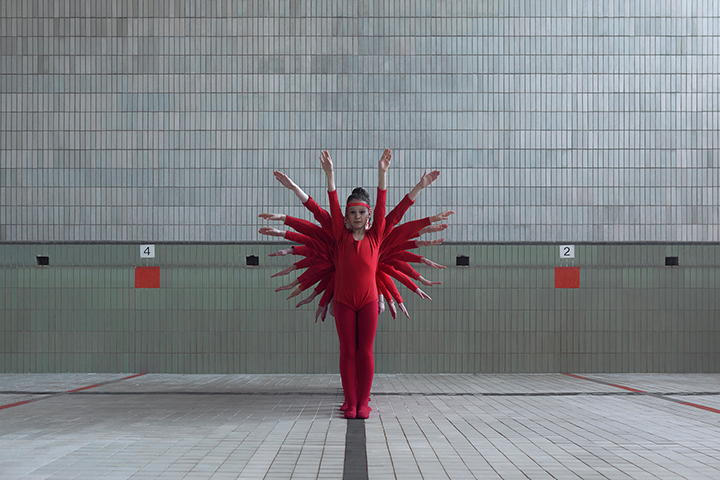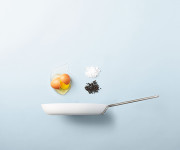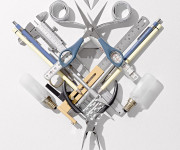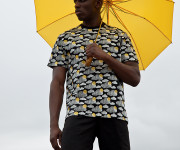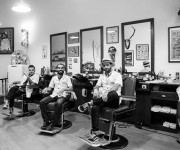A young photographer from Slovakia and much younger experience of her. Although the maturity of her photographs is just amazing. Human figures which is stagnant in the space remind us antique sculptures, mystical environment, cold coloring and plots, usually chosen from mythological stories, philosophical writings and… The Holly Bible. Three years ago, a fatal accident has radical change not only a daily life of Evelyn Bencicova but it led her decision to become a photographer as well. How the famous and breath-taking photo series of “Ecce homo” was born, how does the backstage of her photoshoots look and why she tries to escape from fashion photography – read a whole story in the interview with Evelyn Bencicova:
Who has influenced your choice to become a photographer? Did you think about it since your childhood?
No, I never really thought about it, and even today, I don’t consider myself a photographer. I just use photography as a medium for capturing my ideas and visions.
I started photography almost 3 years ago after eyes surgery, which literally changed my life. For the first time I was able to notice all details of the world what was such a big influence that it can be one of the reasons, why I chose photography as my visual language.
As a child, I was really curious and creative, always discovering, inventing and looking for adventures. Every time, I saw or found something interesting, my first idea was: “What I can create from this?” And till these days I feel this need to bring my inspiration further and give it a new form.
You are from Slovakia but you also spend a lot of time in Berlin. Why? Can you say that Berlin is much better for you as a photographer?
I didn’t move to Berlin yet, I’m just spending a lot of time there but it is not permanent. I go to Berlin to get inspired and to enjoy life, to meet creative people and amazing characters that somehow belong to this city naturally. I have my own idea of Berlin, of another reality, which I need and which creates great contrast with my everyday world (in Slovakia where I live and Vienna where I study) filled with work and studying.
How long you were searching for your own style? Have you already developed it?
I think that something like “my own style” doesn’t exist for a person, who creates. It just comes naturally, that your work reflects what you are, what you like, what you are going through. It is developing every project and every day together with my personality.
You wanted to become a philosopher. Are you still interested in this subject? Does it reflect in your artworks?
Yes, I’m interested in everything. I want to learn as much as possible, gather information and create connections between what I know and what I’m doing. As I mentioned, the kind of photography, which I’m doing, is giving me great opportunity to study various topics I’m interested in (e.g. mythology, religion, philosophy, psychology, history, communication, aesthetics).
In what kind of themes or stories are you interested? Do you create them?
Most of the time I cannot create out of nothing. Project is usually based on certain interest of mine and whole studying and research, which is around it. I’m always creating the vision, the visual that combines my knowledge, imagination and fragment of accident.
What do you think about beauty standards nowadays? Why do you choose a different way to picture people with their imperfections?
I think it is interesting to see the development in human thinking and standards of body or anything else, which are accepted and admired. I work with this topic often also because an idea or ideal of beauty is present in many of my works. It must not be only about person but about beauty in general. It can be also lighting or composition, quality of the image. I’m often criticized by visual language, which I’m using which can remind of fashion or commercial photography. Putting such a focus on aesthetic can be seen as lack of concept and idea but I don’t see it this way as long as concept is present. I’m trying to make pictures interesting for anybody even if not all of the people can read it in a deeper sense.
How do you choose people to be photographed? Are they professional models, random people?
For my own (non commercial) work I usually use people I know (some of them are models but that’s not criteria for me). The most important thing is our good communication, connection between us, understanding of the project and their role in it. Sometimes I also have to risk and use random people but that’s great way to discover new characters for my later work.
Who inspired you to create “Ecce homo”? Why you chose such a classical and religious motif?
“Ecce homo” is the title which refers more to its meaning than to biblical story. Project is about humanity and its essence. I was inspired by everyday life around me. I tried to see the situations in more raw, simplified version.
You use quite limited scale of colors and static, even sculptural compositions. What is the reason for it?
I think this is matter of taste and it changes from time to time. I learn a lot from painting and other forms of art so that can also be a reason.
Why most of models are naked? What is your connection with clothes? Are they important?
Naturalness. Humanity. I’m trying to get a rid of any classification created by clothes or faces. No protection. No difference. I’m trying to show something really general. This project is about anybody and everybody.
How do you choose places and environment for your photo shoots? What kind of role it has in your creative process?
I’m really careful with location scouting. I have to admit that for me it is usually the starting point and I start to see the scene and build the whole vision after I see the place. I have to feel some kind of strange energy, history and story of the whole place and that becomes the photo. Sometimes I work in studio where I need to put more focus on the person but I always prefer to vary shooting location that is also creating most of adventure and excitement.
Do you use any special effects?
No, even when it sometimes may look like big production or special effect scenes are real created just by small team (usually consisting of 2 people) for our own (minimal or no) budget. I’m using Photoshop for postproduction where I work with colors and mostly make the whole picture cleaner in order to focus attention on important things instead of bothering details.
What things inspire or excite you most?
Inspiration is everything. Some of my fascinations are intensity, speed, art, madness, illusion, beauty in its all forms and endless amount of other things.
What is your connection with fashion and fashion photography?
I started with fashion photography and I’m moving a bit further from it but it is still present in my work and portfolio. On one side, I like the idea of creating the illusion with all its beauty concentrated in one particular moment showed on the picture. On the other side, the idea of putting the clothes or another product on the first place is not so suitable and challenging for me but fashion is still strongly influencing my aesthetics.
Do you have any artists you follow and adore?
Not really, but some of my biggest inspirations are Roy Andersson and Andrzej Zulawski.
Do you engage in other projects or collaborations? Or you work independently?
Yes, a lot of projects are collaborations. I’m really thankful for all the people who are helping me and participating, without them nothing what I did so far wouldn’t be possible. Few most important people for me certainly know that I’m speaking mostly about them.
What is your biggest dream as a photographer?
To create something amazing and don’t forget to live.
Thank you!
Photos: Evelyn Bencicova
Visage and assistance: Adam Csoka






